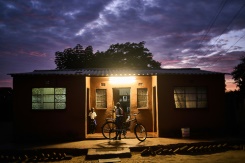It is a sign of the times that last week’s declaration by the Williams Formula One team of its aim to become a climate-positive organisation by 2030, was greeted in muted terms.
It is, of course, a welcome ambition within a sport that guzzles gas and runs up massive bills in flying teams around the world for over 20 races a year but it seems to be very much in line with the way sport is going in 2021.
As world leaders prepare to gather in Glasgow for the United Nations’ Climate Change Conference, also known as COP26, so sports administrators are having to consider new ideas to cut waste and save the planet.
They know by now that it means doing more than simply planting trees by the thousands, manufacturing seats for spectators from recycled plastic or minting medals from used materials.
They know it needs more radical change to recreate a genuinely green playing field.
Credit should be given to some like Forest Green Rovers whose sustainability measures include solar panels, electric car charging points, water recycling, an electric lawnmower, an organic pitch, and an entirely vegan menu for players and fans, prompted FIFA to describe them as “the world’s greenest football club”.
They are the exception. Until now, administrators have largely preferred words to action.
Next year’s big sporting events, the Winter Olympics in Beijing and the World Cup in Qatar, are among the biggest culprits.
Since 1995, the environment has been included in the Olympic charter and in 2016 the International Olympic Committee established a working group to seek ways to make Winter Games “more sustainable and less impactful in financial, operational and environmental terms”.
That will not prevent questions being asked about the artificial snow on the ski slopes at the Winter Olympics in February.
Meanwhile, the World Cup is to be played in the heat of Qatar which, despite moving the tournament to November and December, has necessitated the installation of air conditioning, which emits harmful gases into the atmosphere, in eight stadiums.
– Green pressure –
If the most commercial end of the sporting world is still largely environmentally unsustainable — the 2018 Ryder Cup in France evaluated its water footprint to be equivalent to 197 Olympic swimming pools – there has at least been some movement.
The Williams announcement is the first from an F1 team to align with the UN’s Sports for Climate Action Framework and also fits with Formula 1’s goal, established in 2019, of carbon neutrality by 2030.
“Today, there is more and more pressure on the organisers,” says Didier Lehenaff, who launched the “Eco-Games” in 2004.
An ex-president of the European Triathlon Union, Lehenaff says he “switched to the green side” in the 2000s and committed to “making the sport more eco-compatible”.
He also notes that the Tour de France “has set up areas to throw away waste” and is now punishing recalcitrant teams.
In 2019, the race was dubbed the ‘Tour de Plastique’ because an estimated 15 million items of single-use plastic were dispensed to crowds by sponsors.
– Supporters –
And therein lies another problem. It is not just the cars whizzing around the circuit or the transport of athletes that is the problem, it is the spectators.
In non-Covid days, thousands travel across countries for events each week and others board planes to major international events.
Jerome Lachaze, who looks after social and environmental responsibility at the Le Mans 24 Hours car race, estimates 250,000 people head to the town in northwest France each year and is working to encourage greater use of trains.
He also points out that Le Mans cars will have “100 percent renewable fuel” in 2022 which, according to manufacturers Total Energies, should allow their CO2 emissions to be cut by at least 65 percent.
Appropriately the fuel will be made from French wine residues and ETBE (ethyl tertbutyl ether).
“The pressure is now coming from the sponsors,” Lachaze told AFP.
“They say ‘what is your CSR (corporate social responsibility) strategy?’ And if you do not have this strategy, I will no longer finance you’.”
– ‘Assess, reduce, compensate’ –
Marie Sallois, sustainable development director of the IOC, told AFP the environment has become “a strategic subject” for the organisation since 2015 — 20 years after it was adopted in the charter.
Sallois says the IOC is “attentive to all air transport initiatives on the development of low-carbon solutions” and rejects the idea that the Olympic infrastructures are left to rot once the circus leaves town.
She says “more than 75 percent of existing sites are still in use” of 900 sites from 21st century Games.
For Lehenaff, it is all about “assess, reduce and compensate”.
The ideal is to “reduce the number of infrastructures, their size, increase the compactness of the sites,” he says, adding there is also a need to “reduce the number of competitions”.
He believes the 2024 Paris Olympics organisers are on the right path by promising to halve the CO2 the event produces to 1.5 million tonnes.
Perhaps the organisers will simply attempt to assuage their inability to meet their goal by following in UEFA’s footsteps. It promised to plant 50,000 trees to compensate for spreading this year’s European Championship across 12 countries.
“Awareness is not the same in all countries, in all federations, in all sports,” Lachaze acknowledged.
dec/bsp/gj








